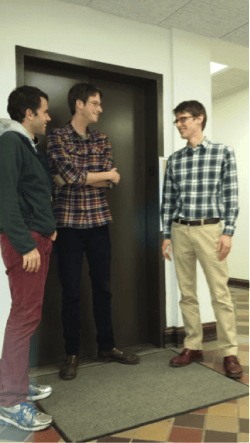In early May, the University of Chicago’s professionalization seminar continued to help graduate students hone their communication skills with a series of student-delivered, impromptu speeches. Last week, our students took their training to a new level by practicing elevator pitches in—where else?—an elevator.
We began with a discussion of what, exactly, a “pitch” should be: a brief encapsulation of one’s research interests, not necessarily bounded by the dissertation. It should also engage listeners whose expertise lay elsewhere. The Career Diversity for Historians initiative, of which U Chicago is a proud participant, encourages students to step out of the particularities of field-specific debates and talk about historical topics with a variety of audiences. The ability to make powerful, accessible arguments is useful in whatever path students take—be it a career in the academy, in public history, or in the private sector.
After reaching a general agreement about the elements of a good pitch, it was time to put these ideas to the test and practice together. Giving students the chance to try out their pitches on one another will, I hope, foster in them the confidence and conviction to thrive in any setting and help them to them achieve a certain professional nimbleness that will serve not only their own careers, but the historical profession and larger society as well.
To guide students through this exercise, we used a “cheat sheet” designed by William Rando of the University of Chicago’s Center for Teaching. After our discussion of aims, each student spent about 10 minutes with the following list of points crucial to a good elevator pitch:
- A hook. Something interesting about your research.
- What does your research do, accomplish?
- Why is it significant, important? How does it change our understanding of topic X?
We then put those scribbles to the test by milling around the room and running into one another, as if at a conference or professional networking event. The room filled with questions and responses: “Nice to see you again. Say, what are you working on these days?” Some answers flowed and some stumbled; some conjured immediately illuminating anecdotes and others built momentum more slowly. After 20 minutes, we reassembled as a group to summarize what we had learned from each participant: “Kyle, you talked with Chris. What did you learn about his research?” Students could hear what others had taken away from their pitch—learning, quite specifically, what worked and what did not. The conversation made clear that our students are doing exciting research but that they need more practice piecing together compelling verbal synopses.
The class culminated with the inspired idea hatched by two students to practice elevator pitches in, well, elevators. A sub-set of the group climbed into the elevator in the Social Sciences building and traveled from the basement to the fifth floor, up and down, and up and down again, to the puzzled looks of fellow passengers. Those travels from floor to floor underscored the importance of brevity: it is possible to say about one sentence per floor. It was also quite fun, reminding us that there is no reason not to occasionally combine history and hilarity. Indeed, the success of our public speaking sessions depends in part on their undeniably low stakes, which encourage forthrightness on the part of graduate students and a willingness to take risks they otherwise might not—an audacity that bodes well for their futures in the academy and beyond.
It is my aim that these sessions give students—most of whom are in the throes of writing dissertations—some perspective on, and pride in, the many talents and skills they have honed over their years of graduate training. To reach the dissertation-writing stage, graduate students have had to collect, synthesize, and interpret large amounts of data, typically with a focus on change over time and with systematic attention to causality. Many students carry out doctoral research using one or more foreign languages and navigating different cultural and political contexts. We are trained to write about our evidence and findings, but we often neglect discussing the processes that brought us to them. This convention means that the unique investigative abilities of the historian often go unremarked and unheralded. But it is arguably these very capacities that help to distinguish historians within the academy and give them an edge beyond it. These are some of the skills that historians need to better communicate within the academy and beyond, and with elevator pitches in hand, U Chicago’s history students are well on their way.
This post first appeared on AHA Today.
Emily Lynn Osborn is associate professor of African history at the University of Chicago. She is a member of the faculty committee directing the U of C’s participation in the AHA’s Career Diversity for Historians initiative. She is also the faculty director of the department’s professionalization workshop for 2014–15.
This work is licensed under a Creative Commons Attribution-NonCommercial-NoDerivatives 4.0 International License. Attribution must provide author name, article title, Perspectives on History, date of publication, and a link to this page. This license applies only to the article, not to text or images used here by permission.





